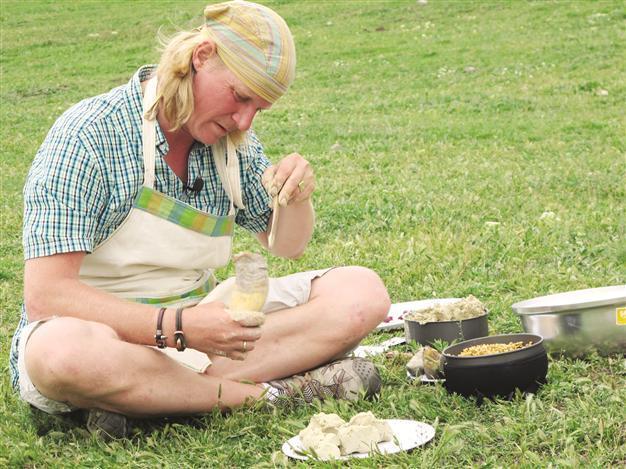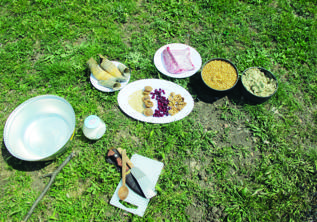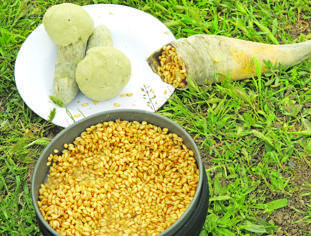Hittite chefs risk death to feed gods
Wilco van Herpen ISTANBUL - Hürriyet Daily News

Wilco Van Herpen is preparing the Hittite food for a program about the Hittite kitchen. He found the horns of some bigheaded
animals and decided to fill these horns and cook the food inside of the horns. It was perfectly cooked. Photos by Wilco van Herpen.
For some strange reason there is not much known about the life of ordinary Hittite people. Don’t get me wrong, a lot of information has been revealed about the Hittite culture, but generally this concerns the life of the priests and the relationship Hittites had to their many gods. The Hittites used to record everything, including cuisine recipes, prayers, the relationships of the priests or chefs toward the gods, really just about absolutely everything.
Many times while traveling around in Turkey and seeing the many beautiful old cultures I wish I could travel back in time. It must be something so wonderful and mind-blowing to be able to walk around in such an old culture. But when I think about the Hittites I am a bit more careful with what I wish. Why? Well, as you might know I am a chef (and a photographer and television presenter) and I always have a lot of fun preparing new dishes. But…
Being a chef during the Hittite Empire was something else. The Gods were the powerful ones and if you were not able to satisfy the needs of the gods that might mean that caused a spell to be placed not only on you but on the whole nation. It was a profession not completely free of risks. If you, as a chef, were not able to prepare the perfect food for your gods you might end up with your head chopped of your body. The ultimate punishment for not presenting well-prepared food during the Hittite era was the death penalty.
 160 kinds of bread
160 kinds of breadFor the thousands of gods the Hittites had they had at least 160 different kinds of bread. Can you imagine that, 160 kinds of bread? Kitchens in the Hittite Empire were rich kitchens and also had many different types of beverages, including beer. Near the village where you would find the capital of the kingdom of Hattusha there is a small museum. Before you decide to go and see the place that once used to be a capital I would like to recommend you visit the museum. There are a lot of things that will help you later visualize the wealth and creativity of the Hittites. After that you can go and discover the capital and then you might be better prepared to ‘see’ how life used to be.
I went there to make a program about the Hittite kitchen and soon found myself in discussion with some archeologists. I developed a theory that was against the fact-finding philosophy of some archeologists I spoke with. My idea was to make some Hittite food. So what would be the plan? Mak ing food is a practical thing. While for the gods the food was the best of the best, the people had to eat the ordinary things. But one day a shepherd was far away from home and he was very hungry so he decided to make food with the basic ingredients he had on hand at that moment. Since it is impossible for a shepherd to carry heavy metal tools like pans he had to find an alternative. Looking around he found the horns of some big-headed animals and decided to fill these horns and cook the food inside of the horns. That was my idea.
The archeologists I spoke with told me that something like that would be impossible, nobody would do something like that, but if I can come up with such a basic and practical solution then definitely the shepherd could. This is where those archeologists made a mistake. How can they know that this never happened?
 Food for people
Food for peopleAll the information about the Hittites was based on the information they have about the gods, but I was making food for people. So there I found myself sitting in front of the gates of the Hattusha castle, digging a hole in the ground. When the hole was deep enough I made a fire and let it burn for a while putting new firewood on the fire over and over again. In the meantime I stuffed my horns with wheat, sheep meat, walnuts, pine tree nuts, dried figs and some dried wild berries. The wheat I had soaked for a couple of days so it just needed only a touch of heat to be cooked. When I had enough hot ashes I stuffed the horns, closed it with clay and cooked it in the hot ash for about 20 minutes.
The idea had been to cook the horns for longer, but there was a terrible thunderstorm approaching so I decided not to wait any longer and take the food out of the hot ash. The bad weather probably saved my live because when I opened the horns everything was perfectly cooked and so tasteful. I never thought it would be such a great dish. Happy with the result, I ate my meal, took one horn with me for Ahmet Uhri, an archeologist who believed in my project and gave it to him. He was in shock. He did not expect such a nice meal from such a basic cooking technique and congratulated me on the result. “Wilco,” he said, “you would be a great Hittite,” A better compliment I could not get from such an Hittite food expert.

 160 kinds of bread
160 kinds of bread Food for people
Food for people